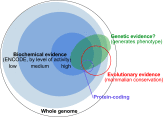Defining functional DNA elements in the human genome
- PMID: 24753594
- PMCID: PMC4035993
- DOI: 10.1073/pnas.1318948111
Defining functional DNA elements in the human genome
Abstract
With the completion of the human genome sequence, attention turned to identifying and annotating its functional DNA elements. As a complement to genetic and comparative genomics approaches, the Encyclopedia of DNA Elements Project was launched to contribute maps of RNA transcripts, transcriptional regulator binding sites, and chromatin states in many cell types. The resulting genome-wide data reveal sites of biochemical activity with high positional resolution and cell type specificity that facilitate studies of gene regulation and interpretation of noncoding variants associated with human disease. However, the biochemically active regions cover a much larger fraction of the genome than do evolutionarily conserved regions, raising the question of whether nonconserved but biochemically active regions are truly functional. Here, we review the strengths and limitations of biochemical, evolutionary, and genetic approaches for defining functional DNA segments, potential sources for the observed differences in estimated genomic coverage, and the biological implications of these discrepancies. We also analyze the relationship between signal intensity, genomic coverage, and evolutionary conservation. Our results reinforce the principle that each approach provides complementary information and that we need to use combinations of all three to elucidate genome function in human biology and disease.
Conflict of interest statement
The authors declare no conflict of interest.
Figures




Comment in
-
Getting "function" right.Proc Natl Acad Sci U S A. 2014 Aug 19;111(33):E3365. doi: 10.1073/pnas.1409762111. Epub 2014 Aug 8. Proc Natl Acad Sci U S A. 2014. PMID: 25107292 Free PMC article. No abstract available.
-
Reply to Brunet and Doolittle: Both selected effect and causal role elements can influence human biology and disease.Proc Natl Acad Sci U S A. 2014 Aug 19;111(33):E3366. doi: 10.1073/pnas.1410434111. Proc Natl Acad Sci U S A. 2014. PMID: 25275169 Free PMC article. No abstract available.
References
-
- Lander ES, et al. International Human Genome Sequencing Consortium Initial sequencing and analysis of the human genome. Nature. 2001;409(6822):860–921. - PubMed
-
- Waterston RH, et al. Mouse Genome Sequencing Consortium Initial sequencing and comparative analysis of the mouse genome. Nature. 2002;420(6915):520–562. - PubMed
Publication types
MeSH terms
Substances
Associated data
- Actions
- Actions
- Actions
Grants and funding
LinkOut - more resources
Full Text Sources
Other Literature Sources
Molecular Biology Databases
Research Materials

